The biocontrol solutions market is projected to grow from USD 5,251.1 million in 2025 to USD 11,872.5 million in 2035, at a CAGR of 8.5%. The growth rate volatility index measures fluctuations in adoption across agriculture, horticulture, and integrated pest management. The overall trajectory remains upward, but short-term oscillations appear during phases of scaling, regulatory adaptation, and regional adoption cycles.
Moderate volatility is likely to appear during the initial phase. Biocontrol products such as microbial pesticides, predatory insects, biofungicides, and pheromone traps require regulatory approval and farmer adaptation. Regional variations in awareness and infrastructure limit consistent adoption. Production costs remain relatively high due to fermentation technologies, formulation complexities, and storage requirements. Shifts in agricultural commodity prices influence demand for biological pest management inputs. Rising interest in residue-free crop protection and regulatory pressure on synthetic pesticides provide growth momentum from 2025 to 2030.
Lower volatility is expected during the later stage. Advances in microbial strain development and formulation technology reduce cost and improve product stability. Supply chains expand through collaborations between agrochemical firms and biocontrol start-ups. Certifications and guidelines for integrated pest management increase confidence among growers. Global demand for organic farming and residue-free exports supports higher adoption. Economies of scale lower price sensitivity, allowing biocontrol products to compete more effectively with synthetic pesticides. Expansion into high-value crops such as fruits, vegetables, and ornamentals creates predictable demand from 2030 to 2035.
The volatility index reflects a transition from early adoption variability to a stabilized expansion pattern. Uneven farmer acceptance, cost barriers, and region-specific regulatory hurdles shape initial oscillations. Stabilization is achieved through technological maturity, global distribution agreements, and integration into sustainable farming systems. Market predictability increases as biocontrol products move from niche applications into mainstream agriculture.
The long-term profile of the market highlights resilience supported by sustainability mandates, government-backed agricultural policies, and rising consumer demand for safe food. Microbial pesticides, beneficial nematodes, bioinsecticides, and bioherbicides with proven field efficacy reinforce adoption. Market confidence grows with advances in shelf-life extension, controlled release formulations, and compatibility with conventional crop protection programs. The volatility index illustrates consistent demand across agricultural regions, with minor fluctuations absorbed by long-term drivers.
The biocontrol solutions market demonstrates a pattern of moderate early volatility followed by stable expansion. The shift from pilot adoption to widespread integration ensures long-term predictability. Growth is anchored by regulatory restrictions on synthetic chemicals, expansion of organic farming, and innovation in microbial and macrobial control products through 2035.
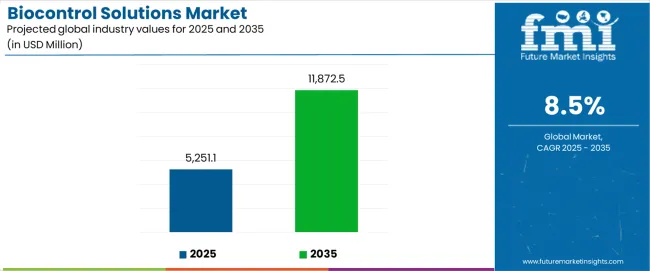
| Metric | Value |
|---|---|
| Estimated Value in (2025E) | USD 5,251.1 million |
| Forecast Value in (2035F) | USD 11,872.5 million |
| Forecast CAGR (2025 to 2035) | 8.5% |
From 2030 to 2035, the market is forecast to grow from USD 7,895.8 million to USD 11,872.5 million, adding another USD 3,976.7 million, which constitutes 60.1% of the overall ten-year expansion. This period is expected to be characterized by the advancement of digital application monitoring systems, the integration of automated biocontrol deployment technologies for precision agriculture, and the development of specialized biological agent combinations for enhanced pest control effectiveness. The growing emphasis on crop yield optimization and ecological pest management will drive demand for premium varieties with enhanced target specificity credentials, improved field persistence options, and superior performance characteristics.
Between 2020 and 2024, the biocontrol solutions market experienced accelerated growth, driven by increasing awareness of chemical residue concerns and growing recognition of biological control systems' effectiveness in supporting efficient crop protection operations across agricultural facilities and commercial farming services. The market developed as growers recognized the potential for biological agents to deliver productivity advantages while meeting modern requirements for export compliance and reliable pest management performance. Technological advancement in production processes and quality assurance systems began emphasizing the critical importance of maintaining biological activity standards while extending product storage life and improving farmer satisfaction across diverse agricultural applications.
Market expansion is being supported by the increasing global demand for residue-free food production and the corresponding shift toward biological pest management solutions that can provide superior ecological characteristics while meeting user requirements for effective pest control and cost-efficient agricultural practices. Modern farmers are increasingly focused on incorporating biological control systems that can enhance productivity while satisfying demands for environmentally responsible, precisely targeted pest management and optimized input utilization practices. Biocontrol solutions' proven ability to deliver pest control efficacy, environmental protection, and diverse application possibilities makes them essential components for progressive farmers and quality-conscious agricultural professionals.
The growing emphasis on integrated pest management and ecological farming optimization is driving demand for high-performance biological control systems that can support distinctive crop protection outcomes and comprehensive ecosystem preservation across organic farming, conventional agriculture, and specialty crop applications. User preference for solutions that combine biological effectiveness with operational flexibility is creating opportunities for innovative implementations in both traditional and emerging agricultural applications. The rising influence of precision agriculture processes and advanced monitoring technologies is also contributing to increased adoption of specialized biocontrol agents that can provide authentic performance benefits and reliable pest management characteristics.
The market is segmented by product type, application, target organism, formulation type, and region. By product type, the market is divided into microbials, semiochemicals, natural substances, invertebrate biocontrol agents, and others. Based on application, the market is categorized into agriculture, forestry, horticulture, and others. By target organism, the market includes insect pests, plant diseases, weeds, nematodes, and others. By formulation type, the market encompasses liquid formulations, powder formulations, granular formulations, and gel formulations. Regionally, the market is divided into North America, Europe, Asia Pacific, Latin America, Middle East & Africa, and other regions.
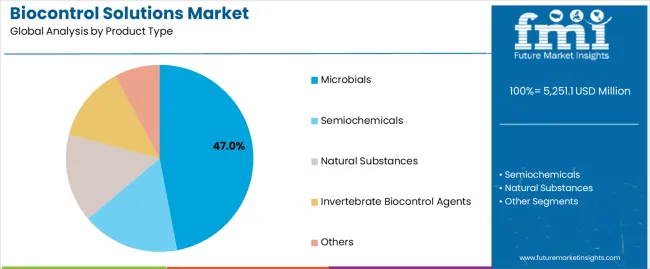
The microbials segment is projected to account for 47.0% of the biocontrol solutions market in 2025, reaffirming its position as the leading product category. Farmers and agricultural professionals increasingly utilize microbial solutions for their superior biological control characteristics, established efficacy standards, and essential functionality in diverse crop protection applications across multiple farming systems. Microbials' proven performance characteristics and established cost-effectiveness directly address user requirements for reliable pest management and optimal crop protection precision in commercial applications.
This product segment forms the foundation of modern biological pest control patterns, as it represents the component category with the greatest biological impact potential and established compatibility across multiple crop systems. Agricultural investments in advanced microbial technology and performance optimization continue to strengthen adoption among efficiency-conscious farmers. With users prioritizing pest control effectiveness and environmental compatibility, microbials align with both productivity objectives and ecological requirements, making them the central component of comprehensive integrated pest management strategies.
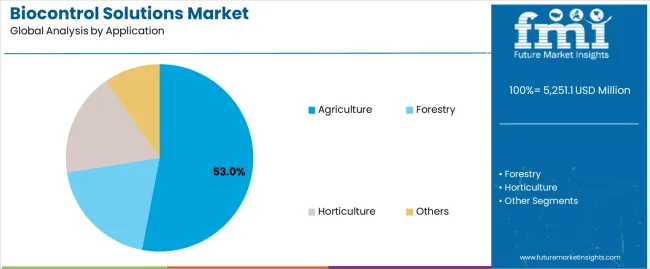
Agriculture is projected to represent 53.0% of the biocontrol solutions market in 2025, underscoring its critical role as the primary application for quality-focused farmers seeking superior pest management efficiency benefits and enhanced crop protection credentials. Commercial growers and agricultural professionals prefer agricultural applications for their established crop coverage, proven market demand, and ability to maintain exceptional pest control quality while supporting versatile protection requirements during diverse growing seasons. Positioned as essential applications for performance-conscious farmers, agricultural offerings provide both operational excellence and competitive positioning advantages.
The segment is supported by continuous improvement in biological control technology and the widespread availability of established agricultural standards that enable quality assurance and premium positioning at the farm level. The agricultural companies are optimizing biocontrol selections to support crop differentiation and competitive production strategies. As biological control technology continues to advance and farmers seek efficient pest management methods, agricultural applications will continue to drive market growth while supporting farm development and crop quality strategies.
The biocontrol solutions market is advancing rapidly due to increasing environmental consciousness and growing need for biological pest management solutions that emphasize superior ecological outcomes across agricultural segments and crop protection applications. The market faces challenges, including competition from chemical pesticide technologies, biological agent stability complexities, and product cost pressures affecting operational economics. Innovation in microbial preservation integration and advanced formulation technologies continues to influence market development and expansion patterns.
The growing adoption of biocontrol solutions in organic farming and integrated pest management systems is enabling farmers to develop crop protection strategies that provide distinctive ecological benefits while commanding competitive positioning and enhanced food safety characteristics. Organic applications provide superior environmental compatibility while allowing more sophisticated biological control features across various crop categories. Users are increasingly recognizing the operational advantages of biological positioning for premium crop outcomes and ecology-conscious farming integration.
Modern biocontrol solution manufacturers are incorporating advanced monitoring technologies, digital efficacy tracking systems, and automated application scheduling to enhance biological precision, improve agent effectiveness, and meet commercial demands for intelligent crop protection solutions. These systems improve operational effectiveness while enabling new applications, including predictive pest management programs and biological optimization protocols. Advanced monitoring integration also allows farmers to support productivity leadership positioning and quality assurance beyond traditional pest control operations.
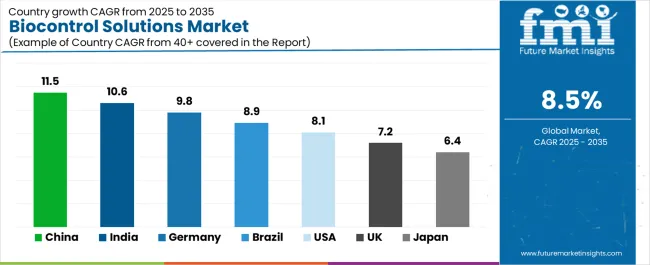
| Country | CAGR (2025-2035) |
|---|---|
| China | 11.5% |
| India | 10.6% |
| Germany | 9.8% |
| Brazil | 8.9% |
| USA | 8.1% |
| UK | 7.2% |
| Japan | 6.4% |
The biocontrol solutions market is experiencing exceptional growth globally, with China leading at an 11.5% CAGR through 2035, driven by the expanding organic agriculture sector, growing biological pest management requirements, and increasing adoption of environmentally conscious farming systems. India follows at 10.6%, supported by rising agricultural modernization, expanding crop protection needs, and growing acceptance of biological control solutions. Germany shows growth at 9.8%, emphasizing established agricultural capabilities and comprehensive biological technology development. Brazil records 8.9%, focusing on agricultural expansion and crop protection enhancement. The USA demonstrates 8.1% growth, prioritizing advanced biological technologies and farming optimization.
The report covers an in-depth analysis of 40+ countries, Top-performing countries are highlighted below.
Revenue from biocontrol solutions consumption and sales in China is projected to exhibit exceptional growth with a CAGR of 11.5% through 2035, driven by the country's rapidly expanding organic agriculture sector, favorable government policies toward biological pest management, and initiatives promoting advanced crop protection technologies across major agricultural regions. China's position as a leading agricultural producer and increasing focus on food safety compliance are creating substantial demand for high-quality biocontrol solutions in both domestic and export markets. Major agricultural companies and farming cooperatives are establishing comprehensive biological control capabilities to serve growing demand and emerging market opportunities.
Revenue from biocontrol solutions products in India is expanding at a CAGR of 10.6%, supported by rising agricultural investment, growing crop protection awareness, and expanding farmer education capabilities. The country's developing agricultural sector and increasing commercial investment in biological pest management technologies are driving demand for biocontrol solutions across both traditional and modern farming applications. International agricultural companies and domestic distributors are establishing comprehensive operational networks to address growing market demand for biological pest control and efficient crop protection solutions.
Revenue from biocontrol solutions products in Germany is projected to grow at a CAGR of 9.8% through 2035, supported by the country's mature agricultural sector, established environmental standards, and leadership in biological technology. Germany's sophisticated agricultural infrastructure and strong support for advanced crop protection systems are creating steady demand for both traditional and innovative biological control varieties. Leading agricultural companies and specialty distributors are establishing comprehensive operational strategies to serve both domestic markets and growing export opportunities.
Revenue from biocontrol solutions products in Brazil is projected to grow at a CAGR of 8.9% through 2035, driven by the country's emphasis on agricultural expansion, crop diversification, and growing biological pest management capabilities. Brazilian farmers and agricultural companies consistently seek commercial-grade biological solutions that enhance crop protection efficiency and support operational excellence for both traditional and modern farming applications. The country's position as a Latin American agricultural leader continues to drive innovation in specialized biocontrol applications and commercial agricultural standards.
Revenue from biocontrol solutions products in the USA is projected to grow at a CAGR of 8.1% through 2035, supported by the country's emphasis on agricultural technology advancement, crop protection optimization, and advanced biological integration requiring efficient pest management solutions. American farmers and agricultural users prioritize performance reliability and ecological precision, making specialized biological solutions essential components for both traditional and modern farming applications. The country's comprehensive technology leadership and advancing agricultural patterns support continued market expansion.
Revenue from biocontrol solutions products in the UK is projected to grow at a CAGR of 7.2% through 2035, supported by established agricultural standards, mature farming markets, and emphasis on environmental responsibility across commercial and specialty farming sectors. British farmers and agricultural professionals prioritize quality performance and ecological consistency, creating steady demand for premium biological solutions. The country's comprehensive market maturity and established farming practices support continued development in specialized applications.
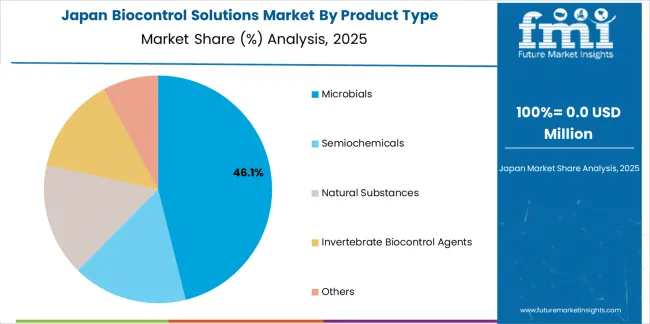
Revenue from biocontrol solutions products in Japan is projected to grow at a CAGR of 6.4% through 2035, supported by the country's emphasis on precision agriculture, quality excellence, and advanced technology integration requiring efficient biological solutions. Japanese businesses and agricultural users prioritize technical performance and agricultural precision, making specialized biological solutions essential components for both traditional and modern farming applications. The country's comprehensive quality leadership and advancing agricultural patterns support continued market expansion.
The Europe biocontrol solutions market is projected to grow from USD 1,685.2 million in 2025 to USD 3,598.4 million by 2035, recording a CAGR of 7.9% over the forecast period. Germany leads the region with a 38.4% share in 2025, moderating slightly to 37.9% by 2035, supported by its strong agricultural base and demand for premium, technically advanced biological pest management solutions. The United Kingdom follows with 21.8% in 2025, easing to 21.3% by 2035, driven by a mature farming market and emphasis on environmental responsibility and performance optimization.
France accounts for 18.2% in 2025, rising to 18.7% by 2035, reflecting steady adoption of organic farming solutions and operational efficiency enhancement. Italy holds 10.6% in 2025, expanding to 11.2% by 2035 as specialty crop production and biological pest management applications grow. Spain contributes 5.9% in 2025, growing to 6.3% by 2035, supported by expanding agricultural sector and farming modernization. The Nordic countries rise from 3.4% in 2025 to 3.7% by 2035 on the back of strong technology adoption and advanced agricultural methodologies. BENELUX remains at 1.7% share across both 2025 and 2035, reflecting mature, efficiency-focused agricultural markets.
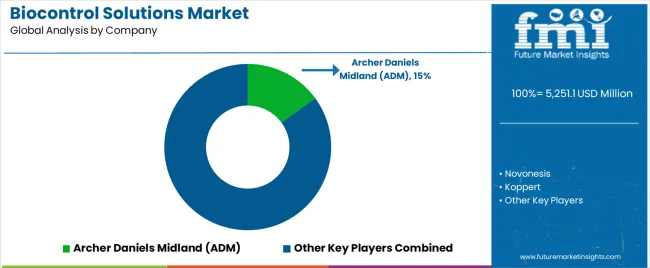
The biocontrol solutions market is characterized by competition among established agricultural companies, specialized biological control producers, and integrated crop protection solution companies. Companies are investing in biological production technologies, advanced formulation development systems, product innovation capabilities, and comprehensive distribution networks to deliver consistent, high-quality, and reliable biocontrol systems. Innovation in efficacy enhancement, stability optimization, and application-specific product development is central to strengthening market position and customer satisfaction.
Archer Daniels Midland (ADM) leads the market with a strong focus on agricultural innovation and comprehensive biocontrol solutions, offering commercial biological systems with emphasis on manufacturing excellence and technological heritage. Novonesis provides specialized biological control products with a focus on agricultural market applications and performance engineering networks. Koppert delivers integrated biological solutions with a focus on grower positioning and operational efficiency. Rovensa Next specializes in comprehensive crop protection biologicals with an emphasis on precision applications. BASF focuses on comprehensive agricultural biological solutions with advanced research and premium positioning capabilities.
The success of biocontrol solutions in meeting commercial agricultural demands, farmer-driven efficiency requirements, and performance integration will not only enhance crop protection outcomes but also strengthen global agricultural production capabilities. It will consolidate emerging regions' positions as hubs for efficient biological production and align advanced economies with commercial agricultural systems. This calls for a concerted effort by all stakeholders -- governments, industry bodies, manufacturers, distributors, and investors. Each can be a crucial enabler in preparing the market for its next phase of growth.
| Items | Values |
|---|---|
| Quantitative Units (2025) | USD 5,251.1 million |
| Product Type | Microbials, Semiochemicals, Natural Substances, Invertebrate Biocontrol Agents, Others |
| Application | Agriculture, Forestry, Horticulture, Others |
| Target Organism | Insect Pests, Plant Diseases, Weeds, Nematodes, Others |
| Formulation Type | Liquid Formulations, Powder Formulations, Granular Formulations, Gel Formulations |
| Regions Covered | North America, Europe, Asia Pacific, Latin America, Middle East & Africa, Other Regions |
| Countries Covered | China, India, Germany, Brazil, United States, United Kingdom, Japan, and 40+ countries |
| Key Companies Profiled | Archer Daniels Midland (ADM), Novonesis, Koppert, Rovensa Next, BASF, and other leading biocontrol solution companies |
| Additional Attributes | Dollar sales by product type, application, target organism, formulation type, and region; regional demand trends, competitive landscape, technological advancements in biological engineering, precision manufacturing initiatives, efficacy enhancement programs, and premium product development strategies |
The global biocontrol solutions market is estimated to be valued at USD 5,251.1 million in 2025.
The market size for the biocontrol solutions market is projected to reach USD 11,872.5 million by 2035.
The biocontrol solutions market is expected to grow at a 8.5% CAGR between 2025 and 2035.
The key product types in biocontrol solutions market are microbials , semiochemicals, natural substances, invertebrate biocontrol agents and others.
In terms of application, agriculture segment to command 53.0% share in the biocontrol solutions market in 2025.






Our Research Products

The "Full Research Suite" delivers actionable market intel, deep dives on markets or technologies, so clients act faster, cut risk, and unlock growth.

The Leaderboard benchmarks and ranks top vendors, classifying them as Established Leaders, Leading Challengers, or Disruptors & Challengers.

Locates where complements amplify value and substitutes erode it, forecasting net impact by horizon

We deliver granular, decision-grade intel: market sizing, 5-year forecasts, pricing, adoption, usage, revenue, and operational KPIs—plus competitor tracking, regulation, and value chains—across 60 countries broadly.

Spot the shifts before they hit your P&L. We track inflection points, adoption curves, pricing moves, and ecosystem plays to show where demand is heading, why it is changing, and what to do next across high-growth markets and disruptive tech

Real-time reads of user behavior. We track shifting priorities, perceptions of today’s and next-gen services, and provider experience, then pace how fast tech moves from trial to adoption, blending buyer, consumer, and channel inputs with social signals (#WhySwitch, #UX).

Partner with our analyst team to build a custom report designed around your business priorities. From analysing market trends to assessing competitors or crafting bespoke datasets, we tailor insights to your needs.
Supplier Intelligence
Discovery & Profiling
Capacity & Footprint
Performance & Risk
Compliance & Governance
Commercial Readiness
Who Supplies Whom
Scorecards & Shortlists
Playbooks & Docs
Category Intelligence
Definition & Scope
Demand & Use Cases
Cost Drivers
Market Structure
Supply Chain Map
Trade & Policy
Operating Norms
Deliverables
Buyer Intelligence
Account Basics
Spend & Scope
Procurement Model
Vendor Requirements
Terms & Policies
Entry Strategy
Pain Points & Triggers
Outputs
Pricing Analysis
Benchmarks
Trends
Should-Cost
Indexation
Landed Cost
Commercial Terms
Deliverables
Brand Analysis
Positioning & Value Prop
Share & Presence
Customer Evidence
Go-to-Market
Digital & Reputation
Compliance & Trust
KPIs & Gaps
Outputs
Full Research Suite comprises of:
Market outlook & trends analysis
Interviews & case studies
Strategic recommendations
Vendor profiles & capabilities analysis
5-year forecasts
8 regions and 60+ country-level data splits
Market segment data splits
12 months of continuous data updates
DELIVERED AS:
PDF EXCEL ONLINE
Biocontrol Agents Market Size and Share Forecast Outlook 2025 to 2035
5PL Solutions Market
mHealth Solutions Market Size and Share Forecast Outlook 2025 to 2035
Long Haul Solutions Market Size and Share Forecast Outlook 2025 to 2035
eClinical Solutions and Software Market Insights - Trends & Forecast 2025 to 2035
E-tailing Solutions Market Growth – Trends & Forecast 2020-2030
Connected Solutions for Oil & Gas Market Insights – Trends & Forecast 2020-2030
WealthTech Solutions Market Size and Share Forecast Outlook 2025 to 2035
Smart Home Solutions Market Size and Share Forecast Outlook 2025 to 2035
Filter Press Solutions Market Size and Share Forecast Outlook 2025 to 2035
Payment Bank Solutions Market Size and Share Forecast Outlook 2025 to 2035
Aviation IoT Solutions Market
Eye Tracking Solutions Market
Hair Thinning Solutions Market Analysis - Size and Share Forecast Outlook 2025 to 2035
Hormonal Acne Solutions Market Analysis - Size and Share Forecast Outlook 2025 to 2035
Drug Delivery Solutions Market Insights - Growth & Forecast 2025 to 2035
Sensitive Skin Solutions Market Size and Share Forecast Outlook 2025 to 2035
Smart Building Solutions Market Size and Share Forecast Outlook 2025 to 2035
Acne Treatment Solutions Market Size and Share Forecast Outlook 2025 to 2035
Neuromarketing Solutions Market Size and Share Forecast Outlook 2025 to 2035

Thank you!
You will receive an email from our Business Development Manager. Please be sure to check your SPAM/JUNK folder too.
Chat With
MaRIA